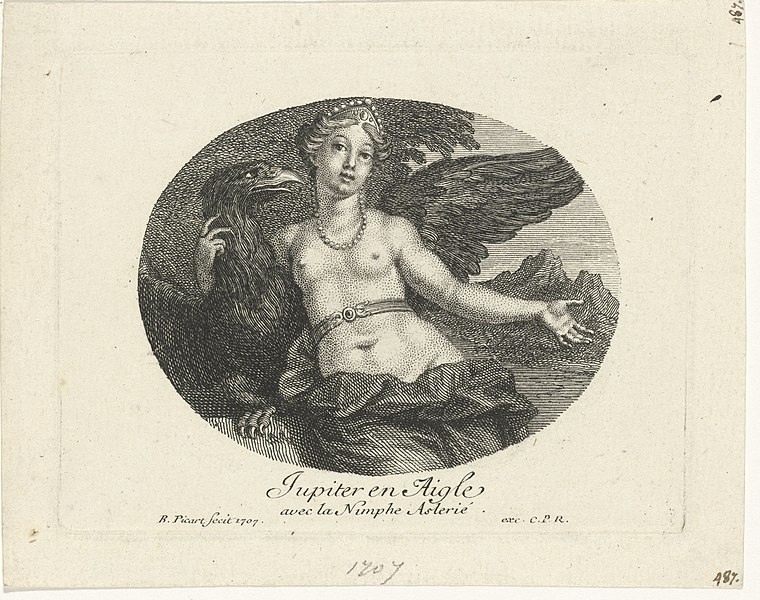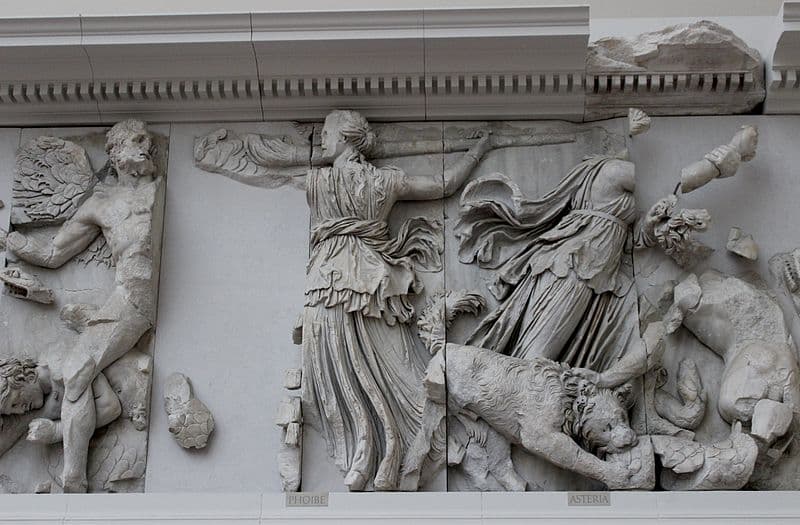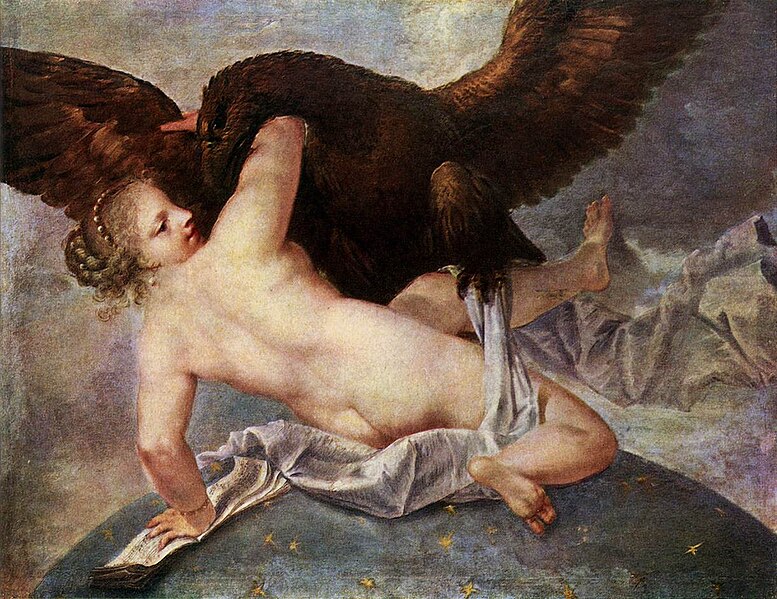In the vast tapestry of Greek mythology, few figures shine as brightly as Asteria. This celestial deity, whose very name evokes the starry night sky, has fascinated scholars and enthusiasts alike for centuries.
Asteria Key Facts
| Parents | Coeus and Phoebe |
| Partners | Perses |
| Siblings | Leto |
| Offspring | Hecate |
| Other names | – |
| Roman name | Astria |
| The Goddess of | Night and Falling Stars |
| Symbols | Stars, quail |
Name and Etymology
Asteria, a name that resonates with the brilliance of the night sky, is derived from the ancient Greek word “ἀστήρ” (astḗr), meaning “star”. This etymology is a direct reflection of her dominion over the night and falling stars. In Roman mythology, she is known as Astria, a slight variation but with the same celestial connotations. Throughout various texts and myths, she might be referred to by epithets or other names, but her essence remains constant: a deity intertwined with the cosmos.

Asteria Origins
Born to the Titans Coeus and Phoebe, Asteria is part of an illustrious lineage. She’s the sister of Leto, making her the aunt of the famed Olympian twins, Apollo, God of Prophecies and Artemis, The Great Huntress,. While her birth was not surrounded by the same level of drama as some other gods, her lineage places her firmly in the pantheon of significant deities.
Asteria’s childhood remains shrouded in mystery, with few myths detailing her early years. However, her role as a personification in Greek myth is profound. She embodies the very essence of the night sky, and as a Daemones (Spirit), she represents the falling stars and nighttime prophecies.
Asteria Lovers and Relationships
Asteria’s love life, like the night sky she governs, is deep and mysterious. Her most notable relationship was with Perses.
Perses and Asteria
Their union was a union of cosmic proportions. Perses, a Titan associated with destruction, found a counterpart in Asteria, the starry night. Together, they gave birth to Hecate. This child, a blend of her parents’ domains, would go on to play a significant role in various myths and legends.
Hecate
Born from the union of Asteria and Perses, Hecate is a deity of immense power and significance. As the goddess of magic and witchcraft, she wields influence in both the mortal and divine realms. Hecate’s divine lineage, with her mother representing the night and her father destruction, makes her a formidable figure in Greek mythology.
Depiction And Characteristics
Asteria is typically depicted as a radiant figure, surrounded by stars and often accompanied by the symbol of a quail. This bird, a symbol of her transformation to escape Zeus, is a constant in her representations. The stars that often surround her not only signify her dominion over the night sky but also her ethereal beauty.
Asteria Personality and Powers
Discussions about Asteria often overlook her personality, focusing more on her appearance. However, the myths surrounding her reveal a strong-willed and independent deity. Demonstrating her independence, she escaped Zeus by transforming into a quail and diving into the sea. Additionally, her association with nighttime prophecies showcases her deep wisdom and connection to the universe’s mysteries.
As a goddess of the night sky and falling stars, Asteria possesses the power to influence the cosmos. Her ability to transform, as seen in her escape from Zeus, showcases her adaptability and strength. Moreover, her connection to nighttime prophecies positions her as a deity with foresight and knowledge of the unknown.
Asteria Symbols
The stars are, without a doubt, the primary symbol associated with Asteria. They represent her dominion and her very essence. Additionally, the quail, a symbol of her transformation and escape, is intrinsically linked to her myth. The vastness of the night sky and its twinkling stars remain her most enduring symbols.
Asteria Roles
Asteria’s primary role in Greek mythology is as the goddess of the night sky and falling stars. Her responsibilities encompass overseeing the cosmos, especially during the nighttime. Additionally, her association with prophecies positions her as a deity with insight into the future, guiding mortals and gods alike with her wisdom.
Myths about Asteria
Asteria’s tales shimmer with intrigue, cosmic wonder, and the spirit of resistance. As we unravel her myths, we not only discover her essence but also the intricate web of relationships and events in Greek mythology.
Asteria’s Escape from Zeus and Connection to Delos
One of the most riveting tales surrounding Asteria is her evasion of Zeus’s advances. Zeus, the omnipotent king of the gods, was captivated by Asteria’s celestial beauty and sought to claim her. However, Asteria, ever the embodiment of independence and resilience, refused to be another conquest. In a dazzling act of defiance, she transformed herself into a quail to elude Zeus’s grasp. But her metamorphosis took an even more profound turn when she plunged into the sea and became the island of Delos. This island would later gain immense significance as the birthplace of the Olympian twins, Apollo and Artemis. Intriguingly, Asteria’s connection to Delos isn’t just geographical; she’s also the aunt of these divine twins, further intertwining their destinies.
The Creation of the Asterism
Asteria’s celestial influence is evident in another enchanting myth. After her transformation into Delos, several stars, deeply moved by her tale, aligned themselves in her honor. This formation, known as an asterism, served as a protective shield and a tribute to the goddess. For sailors navigating the vast seas and stargazers looking up in wonder, this celestial pattern became a symbol of Asteria’s indomitable spirit.
The Oracle of Dreams
Asteria’s dominion extended beyond the night sky; she was also revered for her connection to dreams. In certain myths, she’s portrayed as a deity capable of sending prophetic dreams to mortals. Pilgrims, in search of guidance, would journey to Delos, invoking Asteria’s name and presenting offerings. In return, they hoped to receive visions during their slumber, granting insights or foretelling future events. Interestingly, Morpheus, the god of dreams, would later share this ability to communicate through dreams, suggesting a shared or inherited domain.
Asteria In Ancient Greek Religion
While Asteria might not have as many dedicated temples as some other deities, her influence can be felt in various sacred sites. The island of Delos, her transformed self, is one such site. Pilgrims and worshippers would visit this island, not just for Asteria, but also for her sister Leto and her niece and nephew, Artemis and Apollo.
Representations Of Asteria In Art
Throughout history, Asteria’s celestial allure has inspired countless artists, leaving an indelible mark on the world of art. From intricate pottery designs to grand frescoes, her starry visage has been immortalized in various forms. Let’s explore some of the most notable artworks that depict this enigmatic goddess.
The Delos Frescoes
Found on the very island that Asteria is said to have transformed into, the Delos frescoes date back to the 2nd century BC. These artworks, discovered in the ancient homes and sanctuaries of Delos, often depict scenes from Greek mythology. Among them, Asteria’s transformation and her connection to the night sky are beautifully illustrated. The artists of Delos, living on an island steeped in myth, had a unique perspective on these tales, making their depictions especially poignant.
Athenian Red-Figure Pottery
The renowned Athenian pottery from the 5th century BC vividly illustrates mythological tales through detailed illustrations. On several red-figure vases, they depict Asteria surrounded by stars or in the form of a quail, referencing her escape from Zeus. Situated at the heart of Greek culture and scholarship, the Athenian artisans possessed a deep understanding of these myths. Moreover, their craftsmanship distinctly showcases their reverence for these tales.
The Mosaics of Pergamon
Pergamon, an ancient Greek city located in modern-day Turkey, was home to some of the most exquisite mosaics from the Hellenistic period. Among these, there are depictions of Asteria, often alongside other celestial deities. These mosaics, with their intricate designs and vibrant colors, capture the ethereal beauty of Asteria and her cosmic domain.

Mentions in Ancient Texts
Hesiod’s “Theogony”
Written around the 7th century BC, “Theogony” by Hesiod stands as one of the foundational texts of Greek mythology. Hesiod, a revered ancient Greek poet often placed alongside Homer, offers a genealogical account of the gods in this work. In “Theogony”, Asteria’s lineage and significance are detailed, emphasizing her place within the pantheon of Greek deities.
“And after these Erinyes, Night bore Nemesis, to be a plague on mortal men, and then she bore Deceit and Love and Hateful Age and hard-hearted Strife.”
Apollodorus’ “The Library”
Apollodorus, a scholar from Athens who lived around the 2nd century BC, penned “The Library”, a comprehensive compilation of Greek myths. In this work, Asteria’s tales, especially her transformation into the island of Delos, are recounted. Apollodorus provides a systematic account, making his work a valuable resource for understanding the interconnected tales of Greek mythology.
“Leto, oppressed by labor, after nine days reached Delos and there bore Apollo and Artemis, to whom she was carried by the north wind.”
Hyginus’ “Fabulae”
Hyginus, a Latin author from the 1st century BC, is best known for his “Fabulae”, a collection of myths and legends. While not Greek himself, Hyginus’ work is instrumental in preserving many Greek myths, including those about Asteria. He often provides variations or additional details not found in other sources, making “Fabulae” a treasure trove for enthusiasts and scholars alike.
Frequently Asked Questions
Asteria is the goddess of the night sky and falling stars, representing the vastness and mysteries of the cosmos.
She is the daughter of the Titans Coeus and Phoebe.
Hecate, the goddess of magic and witchcraft, is her daughter.
Yes, she’s the sister of Leto, making her the aunt of Apollo and Artemis.
Hesiod’s “Theogony” is a prominent text that details her origins and significance.
Featured Image Credit: Marco Liberi, Public domain, via Wikimedia Commons

